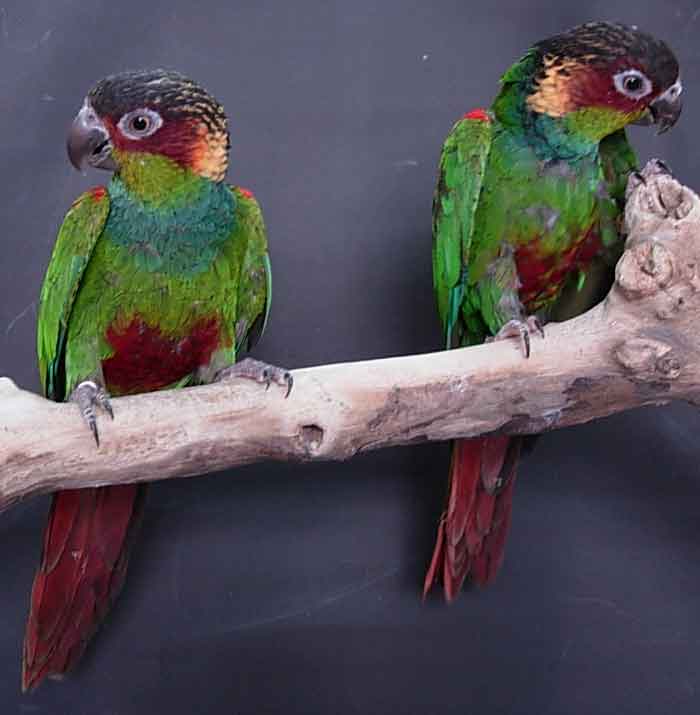
Pyrrhura cruentata (*)
Superregnum: Eukaryota
Cladus: Unikonta
Cladus: Opisthokonta
Cladus: Holozoa
Regnum: Animalia
Subregnum: Eumetazoa
Cladus: Bilateria
Cladus: Nephrozoa
Superphylum: Deuterostomia
Phylum: Chordata
Subphylum: Vertebrata
Infraphylum: Gnathostomata
Megaclassis: Osteichthyes
Cladus: Sarcopterygii
Cladus: Rhipidistia
Cladus: Tetrapodomorpha
Cladus: Eotetrapodiformes
Cladus: Elpistostegalia
Superclassis: Tetrapoda
Cladus: Reptiliomorpha
Cladus: Amniota
Classis: Reptilia
Cladus: Eureptilia
Cladus: Romeriida
Subclassis: Diapsida
Cladus: Sauria
Infraclassis: Archosauromorpha
Cladus: Crurotarsi
Divisio: Archosauria
Cladus: Avemetatarsalia
Cladus: Ornithodira
Subtaxon: Dinosauromorpha
Cladus: Dinosauriformes
Cladus: Dracohors
Cladus: Dinosauria
Ordo: Saurischia
Cladus: Eusaurischia
Subordo: Theropoda
Cladus: Neotheropoda
Cladus: Averostra
Cladus: Tetanurae
Cladus: Avetheropoda
Cladus: Coelurosauria
Cladus: Tyrannoraptora
Cladus: Maniraptoromorpha
Cladus: Maniraptoriformes
Cladus: Maniraptora
Cladus: Pennaraptora
Cladus: Paraves
Cladus: Eumaniraptora
Cladus: Avialae
Infraclassis: Aves
Cladus: Euavialae
Cladus: Avebrevicauda
Cladus: Pygostylia
Cladus: Ornithothoraces
Cladus: Ornithuromorpha
Cladus: Carinatae
Parvclassis: Neornithes
Cohors: Neognathae
Cladus: Neoaves
Cladus: Telluraves
Cladus: Australaves
Ordo: Psittaciformes
Familia: Psittacidae
Subfamilia: Arinae
Tribus: Arini
Genus: Pyrrhura
Species: Pyrrhura cruentata
Name
Pyrrhura cruentata (Wied-Neuwied, 1820)
Synonyms
Psittacus cruentatus (protonym)
References
Wied-Neuwied, M. zu 1820-1821. Reise nach Brasilien in den Jahren; 1815 bis 1817. Frankfurt a.M. H.L. Brönne. Vol.1 BHL. 1820: vi + 376 pp. + 1 (unnumbered), 1 map. Vol.2 BHL. 1821: xviii + 345 pp. + 1 (unnumbered), 16 plates, 1 map. DOI: 10.5962/bhl.title.85967Reference page. Vol. 1, p. 70 BHL
Links
Listed animal in CITES Appendix I
IUCN: Pyrrhura cruentata (Vulnerable)
Vernacular names
български: Синьогуша зеленка
Cymraeg: Conwra gyddflas
Deutsch: Blaulatzsittich
English: Blue-chested Parakeet
suomi: Sinirinta-aratti
français: Conure tiriba
magyar: Pirosfülű papagáj
кырык мары: Симсӹ онган якшар пачан попугай
Nederlands: Blauwkeelparkiet
پنجابی: نیلے گلیوالا طوطا
português: tiriba-grande
русский: Синезобый краснохвостый попугай
中文: 藍喉錐尾鸚鵡
The ochre-marked parakeet (Pyrrhura cruentata) is a species of parrot native to Brazil. It is also known as blue-throated parakeet and red-eared conure in English and tiriba-grande, tiriba, cara-suja and fura-mato-grande in Portuguese.
It is listed as Vulnerable (VU) on the IUCN Red List.[1]
Description
This colourful parakeet is a predominantly green bird with conspicuous red patches on its belly, rump, and shoulder and before, below and behind the eye. The crown is dark brown to blackish, becoming mottled on the nape of the neck, and there is a broad, bright blue bib on the chest, extending thinly around the back of the neck to form a faint collar. The outer primaries are blue, and the tail is olive-green above, and brownish red below.
Habitat
It inhabits the canopy of lowland humid forest and edge, occasionally up to 960 meters. It has also been recorded in small clearings and selectively logged forest, and persists (or at least persisted) in agricultural areas where many forest trees are retained (such as shade cocoa plantations). It feeds on seeds and fruit of secondary growth trees such as Trema micrantha and Cecropia. Feeding on agricultural crops has not been observed in the wild. Breeding apparently occurs in the austral spring, when 2–4 eggs are laid in a tree-cavity.
Distribution
Pyrrhura cruentata was formerly common throughout much of south-east Bahia, Espírito Santo, east Minas Gerais and Rio de Janeiro, Brazil. Its current distribution is highly fragmented and now mostly restricted to isolated reserves. The stronghold is the Sooretama Biological Reserve and adjacent Linhares Forest Reserve, Espírito Santo. It remains common in Estação Vera Cruz (formerly the Porto Seguro Reserve), Bahia. Elsewhere it can be relatively common, but numbers in the large Chapada da Diamantina and Monte Pascoal National Parks, Bahia, appear low.
Population
The population is estimated at 4.8 to 41 individuals per square kilometer times 1030 square kilometers for a total between 4944 and 42,230 individuals. It is best placed within the band 2500–9999 individuals.(Marsden et al. [2000]).
Threats
Extensive and continuing forest clearance is responsible for its current fragmented distribution. Its apparent tolerance of shade cacao plantations provides little hope because shading techniques since the 1980s have involved the use of banana and Erythryna trees, rather than standing forest, and unstable prices have resulted in conversion to pasture. Many remaining populations are now affected by site-specific threats such as conflicts between habitat conservation and the rights of local communities in Monte Pascoal National Park. Trapping for the cage-bird trade is a relatively new phenomenon, but the species is rare in national and international markets.
Conservation efforts
The bird is listed on CITES Appendix I and is protected by Brazilian law. It occurs in the Chapada Diamantina and Monte Pascoal National Parks, Barrolândia Experimental Station, Linhares Forest Reserve, Caratinga Biological Station, Rio Doce and probably Desengano State Parks, and the Córrego Grande, Córrego do Veado and Sooretama Biological Reserves.
References
BirdLife International (2016). "Pyrrhura cruentata". IUCN Red List of Threatened Species. 2016: e.T22685783A93087500. doi:10.2305/IUCN.UK.2016-3.RLTS.T22685783A93087500.en. Retrieved 12 November 2021.
"Appendices | CITES". cites.org. Retrieved 2022-01-14.
Retrieved from "http://en.wikipedia.org/"
All text is available under the terms of the GNU Free Documentation License

